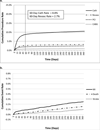Downstream procedures and outcomes after stress testing for chest pain without known coronary artery disease in the United States
- PMID: 22424017
- PMCID: PMC3886123
- DOI: 10.1016/j.ahj.2011.11.022
Downstream procedures and outcomes after stress testing for chest pain without known coronary artery disease in the United States
Abstract
Background: Millions of Americans with suspected coronary artery disease undergo noninvasive cardiac stress testing annually. Downstream procedures and subsequent outcomes among symptomatic patients without known coronary disease referred for stress testing are not well characterized in contemporary community practice.
Methods: We examined administrative insurance billing data from a national insurance provider from November 2004 through June 2007. After excluding patients with prior cardiac disease or chest pain evaluation, we identified 80,676 people age 40 to 64 years with outpatient cardiac stress testing within 30 days after an office visit for chest pain. We evaluated rates of invasive coronary angiography, coronary revascularization, and cardiovascular events after stress testing.
Results: Within 60 days, only 8.8% of stress test patients underwent cardiac catheterization and only 2.7% underwent revascularization; within 1 year, only 0.5% died and had myocardial infarction or stroke. There were marked geographic variations in 1-year rates of catheterization (3.8%-14.8%) and revascularization (1.2%-3.0%) across 20 hospital referral regions.
Conclusions: In this large national cohort of middle-aged patients without previously coded cardiac diagnosis who were referred for stress testing after outpatient chest pain evaluation, few proceeded to invasive angiography or revascularization, and subsequent cardiovascular events were infrequent.
Copyright © 2012 Mosby, Inc. All rights reserved.
Figures




References
-
- Rosamond W, Flegal K, Furie K, et al. Heart disease and stroke statistics--2008 update: a report from the American Heart Association Statistics Committee and Stroke Statistics Subcommittee. Circulation. 2008;117(4):e25–e146. - PubMed
-
- Mark DB, Shaw L, Harrell FE, Jr, et al. Prognostic value of a treadmill exercise score in outpatients with suspected coronary artery disease. N Engl J Med. 1991;325(12):849–853. - PubMed
-
- Hachamovitch R, Berman DS, Kiat H, et al. Exercise myocardial perfusion SPECT in patients without known coronary artery disease: incremental prognostic value and use in risk stratification. Circulation. 1996;93(5):905–914. - PubMed
-
- Picano E, Severi S, Michelassi C, et al. Prognostic importance of dipyridamole-echocardiography test in coronary artery disease. Circulation. 1989;80(3):450–457. - PubMed
-
- Pauker SG, Kassirer JP. The threshold approach to clinical decision making. N Engl J Med. 1980;302(20):1109–1117. - PubMed
Publication types
MeSH terms
Grants and funding
LinkOut - more resources
Full Text Sources
Medical

